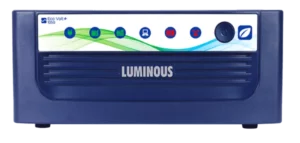Understanding the Basics: How Does a Luminous Inverter Work?
Luminous inverters are a popular choice for households and businesses as they provide backup power during electricity outages. To understand how to troubleshoot any issues with your Luminous inverter, it’s important to first grasp the basics of how it works.
A Luminous inverter is a device that converts DC (direct current) power from batteries into AC (alternating current) power, which is the type of electricity used to power most household appliances. This conversion is necessary because batteries typically store power in the form of DC, while our electrical grid supplies AC power.
When the electricity supply is available, the Luminous inverter charges the connected batteries and simultaneously powers the connected appliances. In the event of a power outage, the inverter automatically switches to battery power, providing an uninterrupted power supply to your appliances until the main power is restored.
The main components of a Luminous inverter include:
- Rectifier: Converts AC power from the electrical grid into DC power to charge the batteries.
- Battery Bank: Stores the DC power received from the rectifier.
- Inverter Circuit: Converts the DC power from the batteries into AC power for your appliances.
- Transfer Switch: Automatically switches between grid power and battery power during power outages.

Identifying Common Issues: Why Is Your Luminous Inverter Not Working?
While Luminous inverters are designed to be reliable and durable, they may encounter issues that require troubleshooting. Here are some common problems you may face and how to identify them:
1. Power Failure
If your Luminous inverter is not working, the first thing to check is whether there is a power failure in your area. If the main power supply is down, the inverter will automatically switch to battery power. In such cases, check the battery charge and ensure it is sufficient to power your appliances.
2. Loose Connections
Loose connections can disrupt the flow of power in your inverter system. Check all the connections, including the battery terminals, input/output cables, and the grounding wire. Tighten any loose connections to ensure a secure and uninterrupted power supply.
3. Overload
If you have connected too many appliances or devices that exceed the inverter’s capacity, it may lead to an overload. In such cases, the inverter may shut down or produce a beeping sound. Disconnect some appliances to reduce the load and restart the inverter.
4. Faulty Batteries
Batteries are crucial for the functioning of a Luminous inverter. If your inverter is not working, it could be due to faulty batteries. Check the battery voltage using a multimeter and ensure it is within the acceptable range. Replace any faulty batteries to restore the functionality of your inverter.
5. Display Errors
Luminous inverters are equipped with a display panel that provides information about the status of the inverter. If you notice any error codes or unusual readings on the display, refer to the user manual for troubleshooting steps specific to your model.
Troubleshooting Step by Step: How to Diagnose and Fix Inverter Problems
If you are experiencing issues with your Luminous inverter, follow these step-by-step troubleshooting tips to diagnose and fix common problems:
- Check the Power Supply: Ensure that the main power supply is available. If not, check the battery charge and the connections between the inverter, batteries, and appliances.
- Inspect the Batteries: Check the battery voltage using a multimeter. If the voltage is below the recommended range, the batteries may need to be charged or replaced.
- Verify the Connections: Inspect all the connections, including the input/output cables, grounding wire, and battery terminals. Tighten any loose connections.
- Reset the Inverter: Sometimes, a simple reset can resolve minor issues. Turn off the inverter, disconnect it from the power source, wait for a few minutes, and then reconnect and restart the inverter.
- Reduce the Load: If the inverter is overloaded, disconnect some appliances to reduce the load. Restart the inverter and check if it functions properly.
- Consult the User Manual: If the troubleshooting steps mentioned above do not resolve the issue, refer to the user manual provided with your Luminous inverter. It may contain specific troubleshooting instructions for your model.
Solving Battery Issues: Tips to Extend the Life of Your Luminous Inverter Battery
The battery is a crucial component of your Luminous inverter system. Here are some tips to extend the life of your battery and ensure optimal performance:
- Proper Ventilation: Ensure the battery is placed in a well-ventilated area to prevent overheating. High temperatures can reduce battery life.
- Regular Maintenance: Clean the battery terminals periodically to remove any corrosion or buildup. This ensures good electrical contact and prolongs the battery life.
- Avoid Deep Discharge: Avoid completely discharging the battery as it can shorten its lifespan. Recharge the battery when the charge level drops to around 50%.
- Use Compatible Batteries: Always use the recommended batteries for your Luminous inverter. Using incompatible or low-quality batteries can lead to performance issues and reduce the lifespan of the battery.
- Proper Charging: Follow the recommended charging procedures provided by the manufacturer. Overcharging or undercharging the battery can affect its performance and longevity.
- Regular Testing: Test the battery voltage periodically using a multimeter to ensure it is within the acceptable range. Replace any faulty batteries promptly.
Inverter Maintenance 101: Essential Tips for Keeping Your Luminous Inverter in Top Shape
Regular maintenance is essential to ensure the optimal performance and longevity of your Luminous inverter. Here are some essential tips to keep your inverter in top shape:
- Cleanliness: Keep the inverter and its surroundings clean and free from dust and debris. Use a soft cloth to wipe the surfaces and ensure proper ventilation.
- Regular Inspections: Periodically inspect all the components of the inverter system, including the batteries, cables, and connections. Look for any signs of wear, corrosion, or damage, and take necessary actions accordingly.
- Timely Repairs: If you notice any issues with your inverter, such as unusual noises, display errors, or performance fluctuations, address them promptly. Delaying repairs can lead to further damage and may require costly repairs.
- Professional Servicing: Schedule regular servicing of your Luminous inverter by a qualified technician. They can perform thorough inspections, clean the internal components, and make any necessary adjustments or repairs.
- Keep the Area Dry: Ensure that the area around the inverter is dry and free from moisture. Moisture can cause corrosion and damage to the electrical components.
Advanced Troubleshooting Techniques: How to Tackle Complex Inverter Problems
While basic troubleshooting can resolve most common issues with Luminous inverters, some problems may require advanced techniques. Here are a few tips to tackle complex inverter problems:
- Advanced Error Codes: If your inverter displays advanced error codes or messages, consult the user manual or contact the manufacturer’s technical support for guidance.
- Software Updates: In some cases, updating the inverter’s firmware or software can resolve complex issues. Check the manufacturer’s website for any available updates and follow the instructions to install them.
- Component Replacement: If the problem persists despite troubleshooting, it may be necessary to replace specific components such as the circuit board, transformer, or capacitors. Consult a qualified technician for assistance.
- Inverter Calibration: Some inverters require calibration to ensure accurate voltage and frequency output. Refer to the user manual for instructions on how to perform inverter calibration.
- System Upgrades: If you frequently encounter issues with your Luminous inverter, it may be worth considering a system upgrade. Newer models often come with advanced features and improved reliability.
Expert Advice on Luminous Inverter Troubleshooting Guide
For expert advice on troubleshooting your Luminous inverter, consider reaching out to authorized service centers or professional technicians. They have the knowledge and experience to diagnose and resolve complex issues with your inverter system.
Frequently Asked Questions about Luminous Inverter Troubleshooting Guide
Q: Why is my Luminous inverter not turning on?
A: There could be various reasons for your Luminous inverter not turning on, including a power failure, loose connections, or a faulty battery. Check the power supply, inspect the connections, and test the battery voltage to identify the cause.
Q: How often should I service my Luminous inverter?
A: It is recommended to service your Luminous inverter at least once a year. However, if you notice any performance issues or unusual behavior, it is advisable to schedule a service appointment promptly.
Q: Can I use any battery with my Luminous inverter?
A: No, it is important to use the recommended batteries for your Luminous inverter. Using incompatible or low-quality batteries can affect the performance and lifespan of the inverter.
Q: Why is my inverter making a beeping sound?
A: A beeping sound from your inverter can indicate an overload, low battery voltage, or a fault in the system. Check the load connected to the inverter, test the battery voltage, and inspect for any error codes on the display panel.
Q: How can I increase the backup time of my Luminous inverter?
A: To increase the backup time of your Luminous inverter, you can add additional batteries to your battery bank or choose batteries with higher capacity. Additionally, reducing the load by disconnecting non-essential appliances can also extend the backup time.






